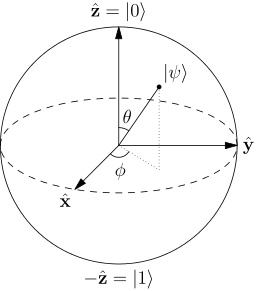Superconducting quantum computing
Superconducting quantum computing is a promising implementation of quantum information technology that involves nanofabricated superconducting electrodes coupled through Josephson junctions. As in a superconducting electrode, the phase and the charge are conjugate variables. There exist three families of superconducting qubits, depending on whether the charge, the phase, or neither of the two are good quantum numbers. These are respectively termed charge qubits, flux qubits, and hybrid qubits.
Theory
Unlike many other physical implementations of a qubit which involve exclusively two-level systems (such as nuclear spin and photon polarization), the integrated quantum circuit involved in a superconducting qubit is a multi-level system, of which only the first two levels are used as the computational basis. A basic requirement for such an implementation is that the energy levels are not uniformly spaced, so that photons of a particular frequency which cause transition between the 0 and 1 levels do not cause transitions from the first level to the higher levels as well. For electronic signals to be carried from one part of the circuit to another without energy loss and hence decoherence, the system also needs to be non-dissipative, i.e., the metallic parts involved should have zero resistance. These circuits currently need to be operated at very low temperatures so that, 1) superconductivity is realized, and 2) thermal fluctuations do not cause transitions between energy levels.
Quantum LC Circuit
The simplest non-dissipative quantum circuit consists simply of an inductor  and capacitor
and capacitor  , with the metallic wires connecting them being superconducting. Here the flux
, with the metallic wires connecting them being superconducting. Here the flux  through the inductor and the charge
through the inductor and the charge  in the capacitor are canonically conjugate variables which obey the commutation relation
in the capacitor are canonically conjugate variables which obey the commutation relation
![[\Phi, Q] = i\hbar](../I/m/5d6ba3dd2f365f3fd0f6c2118dfabff1.png)
The Hamiltonian associated with this system is

which gives rise to the energy levels

where 
Journal articles on superconducting qubits
- Bouchiat, V.; Vion, D.; Joyez, P.; Esteve, D.; Devoret, M. H. (1998). Quantum coherence with a single Cooper pair "Quantum Coherence with a Single Cooper Pair". Physica Scripta 76: 165. Bibcode:1998PhST...76..165B. doi:10.1238/Physica.Topical.076a00165.
- Nakamura, Y.; Pashkin, Yu. A.; Tsai, J. S. (1999). "Coherent control of macroscopic quantum states in a single-Cooper-pair box". Nature 398 (6730): 786. arXiv:cond-mat/9904003. Bibcode:1999Natur.398..786N. doi:10.1038/19718.
- Makhlin, Yuriy; Schön, Gerd; Shnirman, Alexander (2001). "Quantum-state engineering with Josephson-junction devices". Reviews of Modern Physics 73 (2): 357. arXiv:cond-mat/0011269. Bibcode:2001RvMP...73..357M. doi:10.1103/RevModPhys.73.357.
- Vion, D.; Aassime, A; Cottet, A; Joyez, P; Pothier, H; Urbina, C; Esteve, D; Devoret, MH (2002). "Manipulating the Quantum State of an Electrical Circuit". Science 296 (5569): 886–9. arXiv:cond-mat/0205343. Bibcode:2002Sci...296..886V. doi:10.1126/science.1069372. PMID 11988568.
- Martinis, John; Nam, S.; Aumentado, J.; Urbina, C. (2002). "Rabi Oscillations in a Large Josephson-Junction Qubit". Physical Review Letters 89 (11): 117901. Bibcode:2002PhRvL..89k7901M. doi:10.1103/PhysRevLett.89.117901. PMID 12225170.
- Chiorescu, I.; Nakamura, Y; Harmans, CJ; Mooij, JE (2003). "Coherent Quantum Dynamics of a Superconducting Flux Qubit". Science 299 (5614): 1869–71. arXiv:cond-mat/0305461. Bibcode:2003Sci...299.1869C. doi:10.1126/science.1081045. PMID 12589004.
- Duty, T.; Gunnarsson, D.; Bladh, K.; Delsing, P. (2004). "Coherent dynamics of a Josephson charge qubit". Physical Review B 69 (14): 140503. arXiv:cond-mat/0305433. Bibcode:2004PhRvB..69n0503D. doi:10.1103/PhysRevB.69.140503.
- Wallraff, A.; Schuster, D. I.; Blais, A.; Frunzio, L.; Huang, R.- S.; Majer, J.; Kumar, S.; Girvin, S. M.; Schoelkopf, R. J. (2004). "Strong coupling of a single photon to a superconducting qubit using circuit quantum electrodynamics". Nature 431 (7005): 162–7. arXiv:cond-mat/0407325. Bibcode:2004Natur.431..162W. doi:10.1038/nature02851. PMID 15356625.
- Devoret, M.H.; Wallraff, A.; Martinis, J.M. (2004). "Superconducting qubits: A short review". p. 11174. arXiv:cond-mat/0411174. Bibcode:2004cond.mat.11174D.
- You, J. Q.; Nori, Franco (2005). "Superconducting Circuits and Quantum Information". Physics Today 58 (11): 42. arXiv:quant-ph/0601121. Bibcode:2005PhT....58k..42Y. doi:10.1063/1.2155757.
- Zagoskin, A.; Blais, A. (2007). "Superconducting qubits". Physics in Canada 63: 215. arXiv:0805.0164. Bibcode:2008arXiv0805.0164Z.
| ||||||||||||||||||||||||||||||||||||||||||||||
